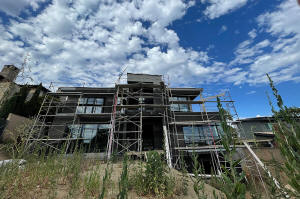Rising rents push US inflation higher; rate cuts still expected in 2024
 Send a link to a friend
Send a link to a friend
 [February 14, 2024] By
Lucia Mutikani [February 14, 2024] By
Lucia Mutikani
WASHINGTON (Reuters) - U.S. consumer prices rose more than expected in
January amid a surge in the cost of rental housing, but the pick-up in
inflation did not change expectations the Federal Reserve will start
cutting interest rates in the first half of this year.
The increase in prices reported by the Labor Department on Tuesday was
the largest in four months and occurred against the backdrop of labor
market strength and economic resilience. But January is typically a
strong month for inflation readings as businesses push through prices
increases at the start of the year, which some economists believed were
not completely addressed by the model used by the government to strip
out seasonal fluctuations from the data.
They also pointed out that not all the drivers of inflation last month
would go into the calculation of the personal consumption expenditures (PCE)
price indexes, the measures tracked by the U.S. central bank to gauge
progress toward its 2% inflation target.
Inflation is slowing, but probably not fast enough to encourage Fed
officials to start easing rates soon.
"It's important not to overreact and jump to the assumption that an
inflationary resurgence is developing," said Seema Shah, chief global
strategist at Principal Asset Management. "Inflation was partially
driven by segments that are less important for the Fed's favored core
PCE measure, while forward looking indicators suggest they will ease
over the coming months."

The consumer price index (CPI) increased 0.3% last month after gaining
0.2% in December, the Labor Department's Bureau of Labor Statistics
said. Shelter, which includes rents, accounted for more than two-thirds
of the rise in the CPI.
Food prices rose 0.4%, the most in a year, which was partly blamed on
winter storms. Grocery food inflation also increased 0.4%, the largest
gain since January 2023, boosted by more expensive sugar and sweets as
well as fats and oils, fruits and vegetables.
Prices for nonalcoholic beverages shot up 1.2%. But cereals and bakery
products were cheaper. Prices for meat, eggs and fish were unchanged.
Gasoline prices dropped 3.3%.
In the 12 months through January, the CPI increased 3.1% after advancing
3.4% in December. Economists polled by Reuters had forecast the CPI
would gain 0.2% on the month and rise 2.9% on a year-on-year basis. The
annual increase in consumer prices has moderated from a peak of 9.1% in
June 2022.
Annual revisions to the CPI data published last Friday generally showed
inflation on a downward trend after surging in 2022. Inflation is one of
the key campaign issues in the Nov. 5 U.S. presidential election.
President Joe Biden in a statement focused on the moderation in annual
inflation, but acknowledged that "we know there's still work to do to
lower costs."
Financial markets pushed back their interest rate-cut expectations to
June from May after the release of the CPI report.
Stocks on Wall Street were trading lower. The dollar rose against a
basket of currencies. U.S. Treasury prices fell.
NO RUSH TO CUT RATES
Policymakers have said they are in no hurry to start lowering borrowing
costs and want convincing evidence that inflation is on a sustained slow
path. Since March 2022, the Fed has raised its policy rate by 525 basis
points to the current 5.25%-5.50% range.

[to top of second column] |

A house under construction is seen in Los Angeles, California, U.S.,
June 22, 2022. REUTERS/Lucy Nicholson/File Photo

Excluding volatile food and energy components, the CPI rose 0.4%
last month. That was the largest advance since last May and followed
a 0.3% increase in December. The so-called core CPI was boosted by a
0.6% surge in shelter after gaining 0.4% in December. Owners'
equivalent rent (OER), a measure of the amount homeowners would pay
to rent or would earn from renting their property, jumped 0.6%. That
was the biggest increase in nine months and followed a 0.4% rise in
December.
New weights published last week increased housing's share and
trimmed that of new and used cars. Those were used to calculate the
January CPI data, together with updated seasonal factors. Rental
inflation has remained elevated despite evidence that the price of
rent demands is going down.
Rent measures in the CPI tend to lag the independent gauges by
several months. There is also a large stock of apartment buildings
in the pipeline, adding to economists' expectations that rents will
lead inflation lower this year.
Economists believe OER's slightly bigger share in the CPI will
contribute to lower inflation readings this year, if the official
rent measures start to align with the private gauges, as expected.
Prices for hotel and motel rooms rebounded as did those for airline
fares in January. Motor vehicle insurance prices increased further.
Medical care services increased 0.7%, with the cost of hospital
services surging 1.6%, the most since October 2015. The cost of
health insurance rose solidly, but prescription medication prices
recorded their biggest decline since February 2021.
Medical care services in the CPI do not go into the calculation of
the PCE price indexes.
"January is often subject to seasonal-adjustment-busting one-time
price increases, especially in services, so this is less a red flag
as a watch-this-space sort of thing," said Mark Streiber, an
economic analyst at FHN Financial in New York.
Services inflation jumped 0.7%, the biggest gain in a year, after
advancing 0.4% in December. Excluding rental shelter, services rose
0.6%, also the largest increase since January 2023, after gaining
0.4%.
Used car and truck prices dropped 3.4%, the largest decrease since
May 1969. Apparel prices fell by the most in nearly three years.
Goods prices dropped 0.3% after being unchanged in December. The
core CPI advanced 3.9% on a year-on-year basis, matching December's
increase.

With the CPI data in hand, economists estimated the core PCE price
index increased 0.3% in January after gaining 0.2% in December. Core
inflation is forecast to rise 2.7% on a year-on-year basis after
increasing 2.9% in December.
These estimates could change depending on the outcome of producer
price data for January, which is due to be released on Friday.
"The good news is that the economy at large remains resilient, and
we think the precise timing of cuts to come, whether that be in May,
June or July, matters less than the direction," said Elyse
Ausenbaugh, global investment strategist at J.P. Morgan Global
Wealth Management.
(Reporting by Lucia Mutikani; Editing by Chizu Nomiyama, Andrea
Ricci and Paul Simao)
[© 2024 Thomson Reuters. All rights
reserved.]
This material may not be published,
broadcast, rewritten or redistributed.
Thompson Reuters is solely responsible for this content. |